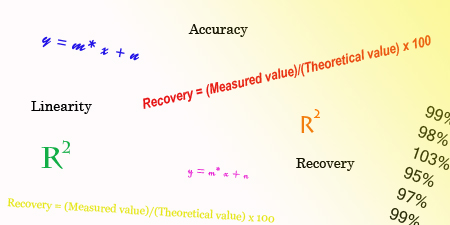Inferring trueness from linearity – 2. Approach: Recovery

In our last blog post we had a look on the first approach to infer trueness from linearity in method validations by applying normalization. This can be used to determine trueness in case no alternative methods or impurities for spiking are available. Apart from normalization, another possibility to solve this problem exists, which will be highlighted today.
We stick to our example of the last time: a SE-HPLC method is used for purity determination. The impurities are given as the sum of minor peaks, while the main peak is our desired product. The approach to infer trueness from linearity is allowed by the ICH Q2(1) validation guideline, when specificity (we suppose this again) and precision is given.
So we take the already known data set (5 concentrations for linearity, each with three independent replicates):
| Absolute peak area [µAU*s] | ||
| Examination level (%) | Sum of minor peaks | Main peak |
| 120 | 99104 | 15949990 |
| 96153 | 15988085 | |
| 97723 | 15879248 | |
| 110 | 89383 | 14567078 |
| 87474 | 14592610 | |
| 88355 | 14558575 | |
| 100 | 77587 | 13275901 |
| 76162 | 13264078 | |
| 78209 | 13285496 | |
| 90 | 65802 | 11513839 |
| 67811 | 11937356 | |
| 68012 | 12037029 | |
| 80 | 54208 | 10489899 |
| 55611 | 10594228 | |
| 56819 | 10683872 | |
and prepare graphs for linearity (for simplification we used the examination level in % instead of the actual product / impurity concentrations in mg/mL):


These figures will help us in determining the theoretical absolute peak areas using the respective regression line (y = m * x + n). Of course, in Excel we can also use the formulas INTERCEPT(known_y's; known_x's) for the y-intercept (n) and SLOPE(known_y's; known_x's) for the slope (m). Thus, our two regression lines consist of the following parameters:
| slope m |
y-intercept n |
|
| Regression lineSum of minor peaks |
1054.2 | -28196 |
| Regression lineMain peak | 134429 | -201743 |
By applying the examination levels as x-values to the regression line (for example, 1054.2 * 120 + (-28196) = 98312), we obtain the following data:
| Absolute peak area [µAU*s] | ||
| Examination level (%) | Sum of minor peaks | Main peak |
| 120 | 98312 | 15929731 |
| 110 | 87770 | 14585442 |
| 100 | 77227 | 13241152 |
| 90 | 66685 | 11896863 |
| 80 | 56143 | 10552573 |
We remember to compare measured values with theoretical values for trueness’ determination. In doing that, we can check the "quality" of our measurements calculating recovery (= measured value / theoretical value * 100%). Recovery is telling us how close our measured values stick to the theoretical ones.
| Sum of minor peaks | Main peak | ||||||
| Examination level (%) | Measured value |
Theoretical value | Recovery [%] | Measured value | Theoretical value | Recovery [%] | |
| 120 | 99104 | 98312 | 101 | 15949990 | 15929731 | 100 | |
| 96153 | 98 | 15988085 | 100 | ||||
| 97723 | 99 | 15879248 | 100 | ||||
| 110 | 89383 | 87770 | 102 | 14567078 | 14585442 | 100 | |
| 87474 | 100 | 14592610 | 100 | ||||
| 88355 | 101 | 14558575 | 100 | ||||
| 100 | 77587 | 77227 | 100 | 13275901 | 13241152 | 100 | |
| 76162 | 99 | 13264078 | 100 | ||||
| 78209 | 101 | 13285496 | 100 | ||||
| 90 | 65802 | 66685 | 99 | 11513839 | 11896863 | 97 | |
| 67811 | 102 | 11937356 | 100 | ||||
| 68012 | 102 | 12037029 | 101 | ||||
| 80 | 54208 | 56143 | 97 | 10489899 | 10552573 | 99 | |
| 55611 | 99 | 10594228 | 100 | ||||
| 56819 | 101 | 10683872 | 101 | ||||
Looking at the recovery rates, we can see that all measured values correspond to almost 100% of the respective theoretical value. Excellent!
With appropriate scientific justification, it can be sufficient for trueness in method validations to solely determine the recovery of the main peak (using absolute peaks areas). Additionally, for both parameters (sum of minor peaks and main peak) precision should be evaluated using relative peak areas (as shown last time).
